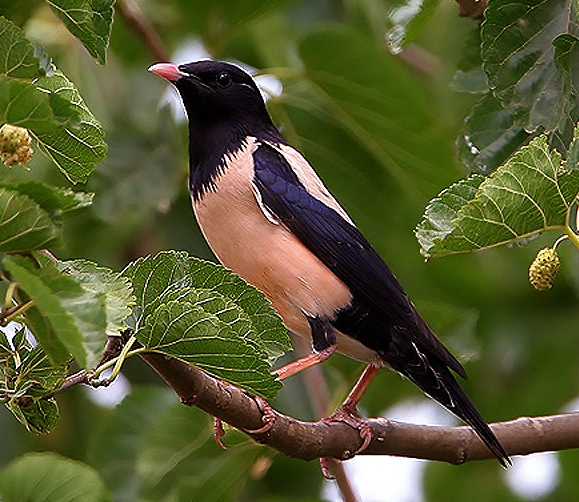 |
| Photo by Eyal Bartov (Eyal Bartov’s Photos) |
Common name:
rosy starling (en); estorninho-rosado (pt); étourneau roselin (fr); estornino rosado (es); rosenstar (de)
Taxonomy:
Order Passeriformes
Family Sturnidae
Range:
This species is found in eastern Europe and central Asia, from Greece, around the Black Sea and into southern Russia, northern Iran, Kazakhstan and north-western China. They migrate south to winter in India.
Size:
These birds are 18-22 cm long and have a wingspan of 37-40 cm. They weigh 60-90 g.
Habitat:
Rosy starlings are mainly found in steppe and semi-desertic areas, namely grasslands, dry savanna, rocky outcrops, pastures and also in agricultural areas such as vineyards and orchards.
Diet:
In spring and summer they are mainly insectivorous, taking grasshoppers, locusts and caterpillars. During the rest of the year their diet also includes a significant portion of nectar, fruits and berries, namely grapes, mulberries, cherries, apricots, dates and even chillies.
Breeding:
Rosy starlings breed in May-July. The nest is rough cup made of grasses and twigs, lined with feather and finer grass, and placed in holes and crevices, such as gaps between rocks in scree slopes or abandoned holes made by other species. The female lays 3-7 pale blue eggs, which are incubated by both parents for 13-16 days. The chicks are fed by both parents and fledge 21-26 days after hatching.
Conservation:
IUCN status – LC (Least Concern)
This species has a very large breeding range and a global population estimated at 500.000-2.500.000 individuals. The population trend is difficult to determine because of uncertainty over the impacts of habitat modification on population sizes.







